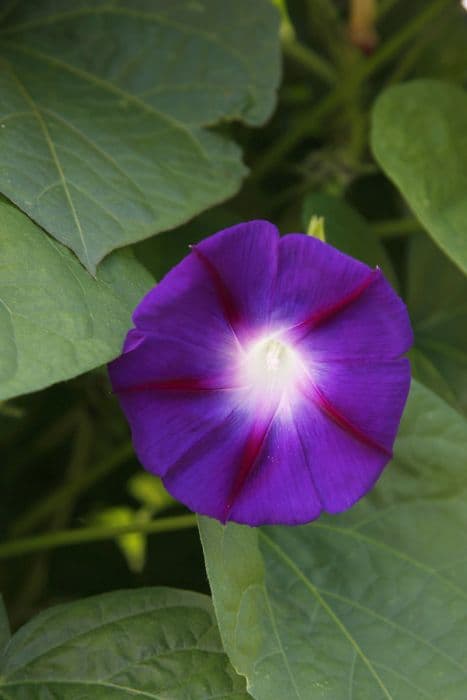Morning Glory Ipomoea tricolor 'Heavenly Blue'

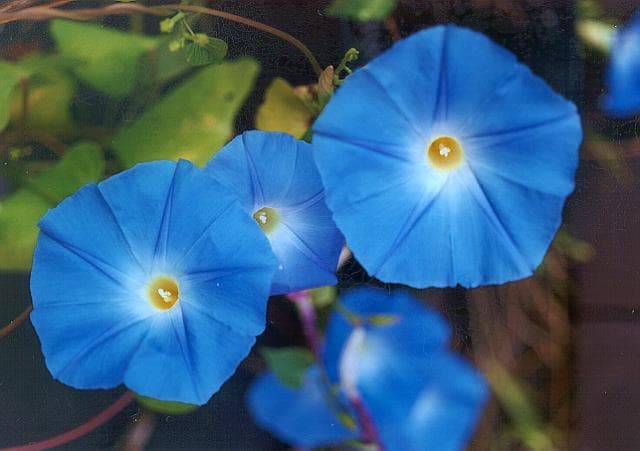

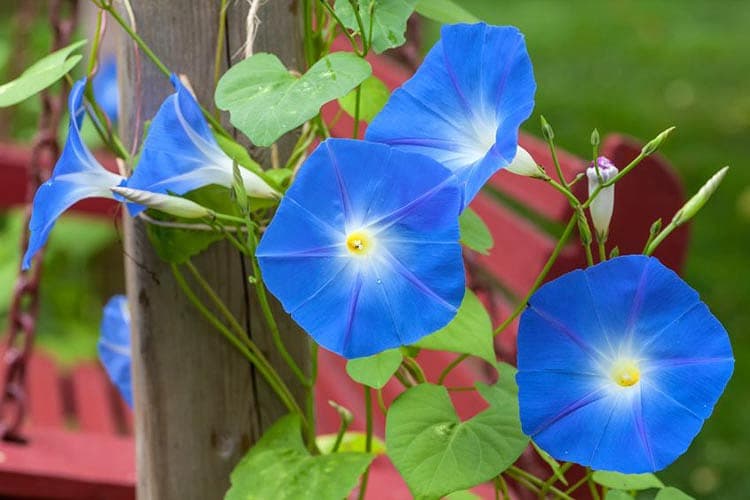
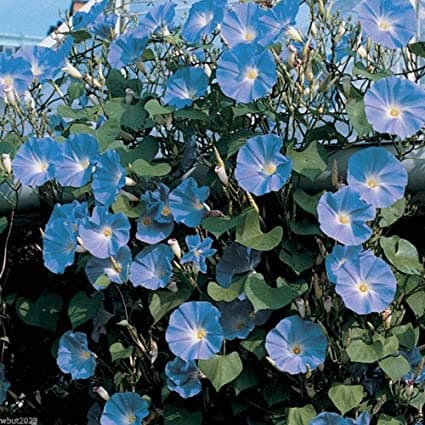
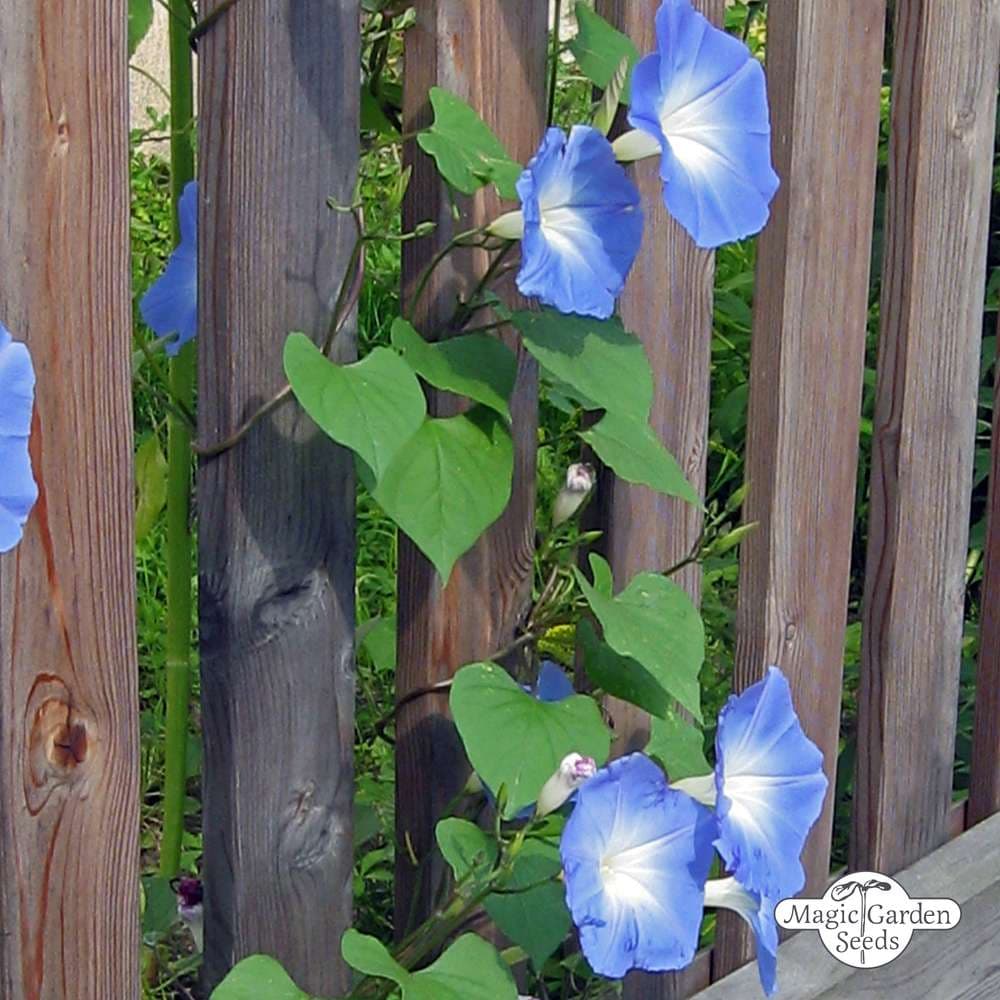
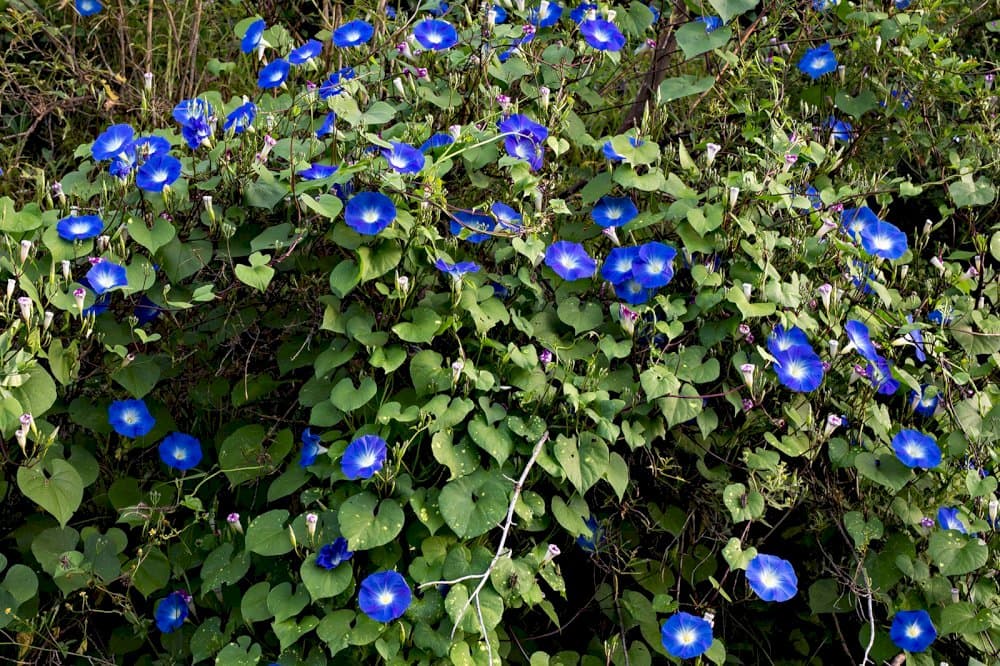

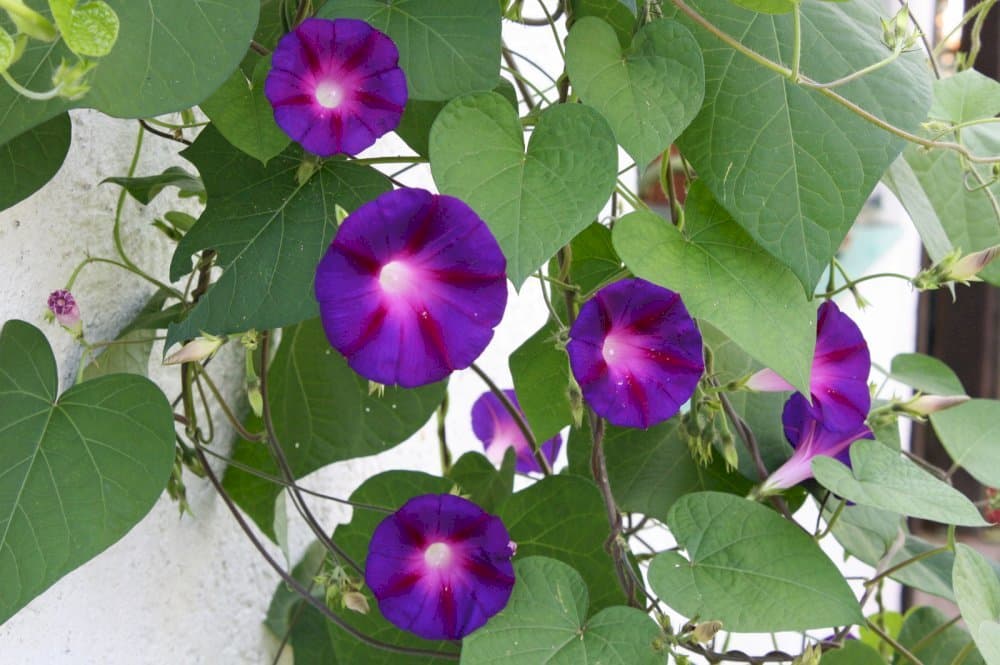
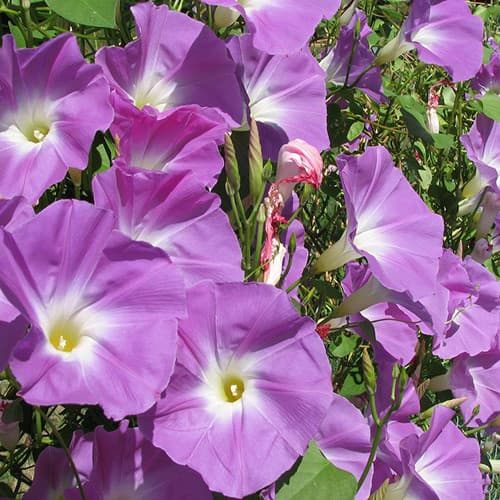
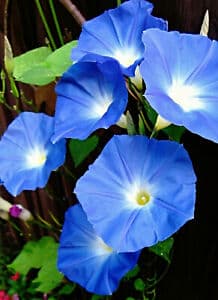
ABOUT
The Morning Glory 'Heavenly Blue' is a captivating climbing plant that is highly prized for its strikingly beautiful flowers. The plant boasts heart-shaped leaves that are lush and provide a dense foliage backdrop for the spectacular blooms that appear throughout the growing season. The most eye-catching feature of Morning Glory 'Heavenly Blue' are its flowers, which are funnel-shaped and exude an ethereal quality. These blossoms are a sky-blue hue with a slight hint of turquoise and have a white throat, creating a mesmerizing contrast that draws the eye. The flowers are generous in size and unfurl in the early morning to greet the day, thus earning the name "Morning Glory." As the day progresses, they usually close by the afternoon, especially when exposed to the hot summer sun. A multitude of these azure flowers can be seen intertwined with the green foliage, creating a stunning display that is often utilized to adorn fences, trellises, or even to cascade beautifully over walls or from hanging baskets. The plant keeps producing new blooms in succession over a long blooming season, providing a continuous spectacle of color. Morning Glory 'Heavenly Blue' is not only adored for its appearance but it also has an easy-growing nature that makes it a favorite among garden enthusiasts. When planted in a sunny spot with well-draining soil, it quickly wraps its way around any support provided, creating a vertical tapestry of vivid blue and verdant green. Its twining stems give it a delicate, yet exuberant growth habit as they spiral upwards. The overall appearance of the Morning Glory 'Heavenly Blue' is one of tranquility and beauty, making it a sought-after variety for providing a quick and easy burst of color in gardens and outdoor spaces.
About this plant
 Names
NamesFamily
Convolvulaceae
Synonyms
Morning Glory, Heavenly Blue, Grannyvine, Flying Saucers
Common names
Ipomoea rubrocaerulea, Pharbitis tricolor, Ipomoea hederacea var. expansa, Pharbitis rubrocaerulea.
 Toxicity
ToxicityTo humans
The Morning Glory contains toxic compounds known as lysergic alkaloids, which can be harmful if ingested. Symptoms of poisoning include gastrointestinal upset, such as nausea, vomiting, and diarrhea. Ingesting the seeds in large quantities can potentially lead to hallucinations due to the presence of these naturally occurring alkaloids, which are similar in structure to LSD. Consuming any part of the Morning Glory, particularly the seeds, can result in these toxic effects and should be avoided.
To pets
The Morning Glory is also toxic to pets due to the same lysergic alkaloids present in the plant. If a pet ingests parts of the plant, especially the seeds, they may exhibit symptoms such as vomiting, diarrhea, lethargy, disorientation, or agitation. In more severe cases, ingestion can lead to tremors or seizures. Owners should prevent pets from consuming any part of the Morning Glory and seek veterinary assistance immediately if ingestion is suspected.
 Characteristics
CharacteristicsLife cycle
Annuals
Foliage type
Deciduous
Color of leaves
Green
Flower color
Blue
Height
10 feet (3 meters)
Spread
3 feet (0.9 meters)
Plant type
Climber
Hardiness zones
10
Native area
Central America
Benefits
 General Benefits
General Benefits- Aesthetic Appeal: The vibrant blue flowers of the Morning Glory add beauty and color to gardens and outdoor spaces.
- Easy to Grow: This plant is known for being easy to cultivate, requiring minimal maintenance once established.
- Quick Coverage: Morning Glory vines grow rapidly and can quickly cover trellises, fences, and other structures, providing privacy and shade.
- Pollinator Attraction: The flowers attract bees, butterflies, and hummingbirds, supporting local ecosystems and pollination.
- Erosion Control: The dense growth habit of the Morning Glory can help stabilize soil and prevent erosion on slopes or in other vulnerable areas.
- Seasonal Interest: Morning Glory provides seasonal interest with its flowers typically blooming from early summer until the first frost.
 Medical Properties
Medical PropertiesThis plant is not used for medical purposes.
 Air-purifying Qualities
Air-purifying QualitiesThis plant is not specifically known for air purifying qualities.
 Other Uses
Other Uses- Artistic Inspiration: The vibrant blue flowers of Morning Glory can be used as a subject or inspiration in various forms of art, including painting, photography, and textile design, due to their unique color and shape.
- Natural Dye: The pigments from the Morning Glory petals can be used to create natural dyes for fabrics, providing a range of blue hues.
- Educational Tool: The fast-growing nature and visible seed-to-flower stages of the Morning Glory make it useful for teaching children about plant biology and the lifecycle of plants.
- Garden Design: Morning Glory can be strategically planted to create living walls or privacy screens in gardens, due to their dense foliage and climbing habit.
- Companion Planting: The Morning Glory can be used in companion planting to provide natural support for vegetables like cucumbers by allowing them to climb the sturdy vines.
- Landfill Cover: Morning Glory can be used in covering landfills or waste grounds, as they are fast to take root and spread, providing quick coverage and improving aesthetics.
- Butterfly and Bee Attractant: The Morning Glory can function as a pollinator attractant in gardens, drawing in butterflies and bees which play a crucial role in the pollination of other plants.
- Photography Projects: Morning Glory's distinctive flowers are an excellent subject for macro photography projects due to their detailed and colorful structures.
- Festive Decor: Fresh or dried Morning Glory vines and flowers can be used in creating natural and eco-friendly festive decor, like wreaths or garlands for events and celebrations.
- Research Subject: The rapid growth and easy cultivation of Morning Glory make it a valuable model organism in scientific studies related to vine growth and flowering patterns.
Interesting Facts
 Feng Shui
Feng ShuiThe Morning Glory is not used in Feng Shui practice.
 Zodiac Sign Compitability
Zodiac Sign CompitabilityThe Morning Glory is not used in astrology practice.
 Plant Symbolism
Plant Symbolism- Expansion and Growth: The 'Heavenly Blue' morning glory climbs and expands rapidly, symbolizing personal or spiritual growth.
- Resilience: It can thrive in poor soil, symbolizing the ability to overcome challenging conditions.
- Renewal: The flowers open in the morning and fade by afternoon, symbolizing the idea of renewing each day with a fresh start.
- Love and Affection: In Victorian Language of Flowers, morning glories represent love and affection due to their twining nature.
- Transience of Life: Their short-lived flowers can also remind us of the fleeting nature of life.
 Water
WaterMorning Glory, commonly known as 'Heavenly Blue', should be watered regularly, especially during dry periods. Aim to keep the soil consistently moist but not soggy. Water them deeply once a week, providing about 1 to 1.5 gallons of water per plant. In hotter climates or during particularly hot and dry spells, you might need to water them twice a week. Always check the top inch of the soil; if it feels dry, it's time to water again.
 Light
LightHeavenly Blue Morning Glories prefer full sun to thrive. They should be planted in a spot where they can receive at least 6 to 8 hours of direct sunlight each day. However, in extremely hot climates, they can benefit from light afternoon shade to protect them from intense heat.
 Temperature
TemperatureMorning Glories like Heavenly Blue are tolerant to a range of temperatures but perform best when daytime temperatures are between 70°F and 80°F. They can withstand minimum temperatures of about 45°F, but frost can damage or kill the plant. It's best to plant them when the threat of frost has passed and consistently warmer temperatures are expected.
 Pruning
PruningPruning Heavenly Blue Morning Glories is generally done to shape the vine and encourage bushier growth. Prune them lightly throughout the growing season as needed. The best time to prune is in late winter or early spring before the new growth starts. Pruning is not mandatory but can keep the vine manageable and attractive.
 Cleaning
CleaningAs needed
 Soil
SoilMorning Glory 'Heavenly Blue' thrives best in a soil mix that is light, well-draining, and rich in organic matter. A mixture of loamy soil, peat, and perlite or sand can create the ideal environment for this plant. The soil pH should be slightly acidic to neutral, around 6.0 to 7.0, for optimal growth.
 Repotting
RepottingMorning Glory 'Heavenly Blue', being an annual vine, does not typically require repotting as it will complete its lifecycle in one growing season. If grown in a container, start with a pot that can accommodate its growth for the season.
 Humidity & Misting
Humidity & MistingMorning Glory 'Heavenly Blue' is not overly sensitive to humidity levels and can tolerate a wide range, but they do best with moderate ambient humidity.
 Suitable locations
Suitable locationsIndoor
Place in bright, indirect light and keep soil moderately moist.
Outdoor
Full sun location, water regularly, support with trellis or fence.
Hardiness zone
9-11 USDA
 Life cycle
Life cycleMorning Glory 'Heavenly Blue' begins its life as a seed, which upon germination, thrusts out a small radicle that will develop into the primary root. The seedling emerges, displaying its cotyledons (seed leaves), and soon after, true leaves start developing which are heart-shaped and vibrant green. The plant grows rapidly, exhibiting a climbing or sprawling habit, and requires support to ascend. It enters the vegetative stage as the stems lengthen and leaves expand, setting the framework for flowering. The plant initiates the reproductive stage by producing distinctive funnel-shaped blue flowers that bloom typically in the morning and close by the afternoon, followed by the development of seed capsules. After setting seed, the plant completes its annual life cycle, potentially leaving behind seeds that can germinate the following growing season if conditions are favorable.
 Propogation
PropogationPropogation time
Spring-Early Summer
The most popular method for propagating Morning Glory, specifically the Ipomoea tricolor 'Heavenly Blue', is by seed. To propagate, collect the seeds in late summer or early fall after the seed pods have dried. Sow them directly into the ground after the last frost the following spring, or for earlier blooms, start them indoors 4 to 6 weeks before the last frost date. Soak the seeds in water for 24 hours to soften the hard outer shell, which can enhance germination. Sow the seeds about 1/4 inch deep (about 6 millimeters) in well-draining soil and keep them moist until they sprout. Seedlings typically emerge in 7 to 14 days. Once the seedlings grow strong enough and the danger of frost has passed, transplant them to their desired location, ensuring that they have a structure to climb.
